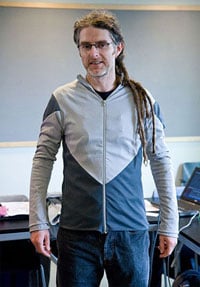"Feel" the Movies With Philips' Tactile Jacket
Not counting tasting popcorn or soda or whatever yummy morsels you might have snuck into a movie theater, the only human senses that are typically engaged in "watching" a movie are seeing and hearing--someone sitting behind you, kicking your seat, doesn't count, as that is not part of the "film's world" (or diegesis as film scholars like to call it). Not that some innovators haven't tried to engage the sense of smell for movies, such as the short-lived Smell-O-Vision or John Waters' tongue-in-cheek, Odorama. But what about the sense of touch? What if someone kicking your seat or a similar sensation was actually part of the film's world and the intended viewer's experience?
That's that question that researchers from Philips Electronics are asking, and they're trying to get their answers using a special jacket they created that contains 64 embedded vibration motors. Each motor can be independently controlled, and the actuators are divided into 16 different arrays, with each four-motor array controlled by a dedicated processor. All the actuators are linked to each other on a serial bus and they are distributed through the jacket's arms and torso.
The purpose of this exercise is not necessarily to reproduce physical sensations from the film. Such haptic devices already exist, such as TN Games' 3rd Space Gaming Vest and its upcoming HTX Helmet. The Philips researchers are more interested in determining what sort of emotional responses touch can elicit from a viewer. They call this "emotional immersion," and it is more akin to providing a sensation such as a "causing a shiver to go up the viewer's spine and creating the feeling of tension in the limbs" or "create a pulsing on the wearer's chest to simulate... [an] elevated heartbeat." This added sensation could serve to make viewers associate more intimately with characters and even empathize with them in. The researchers posit that touch can be a powerful emotional catalyst; Paul Lemmens, a Philips senior scientist, says: "People don't realize how sensitive we are to touch, although it is the first sense that fetuses develop in the womb."
Lemmens has a Ph.D. in cognitive science and is "experienced in experimental psychological research focusing on human information processing that is related to resolving conflicting information in a perceivers environment and the role of emotion in information processing." Lemmens is giving a presentation on research Philips has done with the jacket at the World Haptics conference this week in Salt Lake City, Utah. IEEE Spectrum reports that Philips has previously engaged in similar devices meant to increase viewers' sensations, such as "lighting-effects devices and wind machines that together can simulate the sensation of a gentle breeze or a bomb blast."
If the mind wanders long enough (and for some of us, it doesn't take that long at all), the idea of placing actuators into items of clothing that cause viewers to feel sensations leads to an obvious question. Interestingly, it is a question that Lemmens has already given some thought to:
"Asked if he and his colleagues have any plans to make a matching set of pants, Lemmens says no, but that the possible applications of this technology are limitless and that the emotion-inducing actuators could go anywhere."
That's that question that researchers from Philips Electronics are asking, and they're trying to get their answers using a special jacket they created that contains 64 embedded vibration motors. Each motor can be independently controlled, and the actuators are divided into 16 different arrays, with each four-motor array controlled by a dedicated processor. All the actuators are linked to each other on a serial bus and they are distributed through the jacket's arms and torso.
 |
| Photo credit: Steve Brewster via IEEE Spectrum |
Lemmens has a Ph.D. in cognitive science and is "experienced in experimental psychological research focusing on human information processing that is related to resolving conflicting information in a perceivers environment and the role of emotion in information processing." Lemmens is giving a presentation on research Philips has done with the jacket at the World Haptics conference this week in Salt Lake City, Utah. IEEE Spectrum reports that Philips has previously engaged in similar devices meant to increase viewers' sensations, such as "lighting-effects devices and wind machines that together can simulate the sensation of a gentle breeze or a bomb blast."
If the mind wanders long enough (and for some of us, it doesn't take that long at all), the idea of placing actuators into items of clothing that cause viewers to feel sensations leads to an obvious question. Interestingly, it is a question that Lemmens has already given some thought to:
"Asked if he and his colleagues have any plans to make a matching set of pants, Lemmens says no, but that the possible applications of this technology are limitless and that the emotion-inducing actuators could go anywhere."

